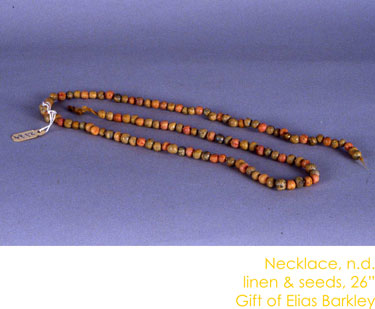
 |
 | |
 |
The Everhart Museum has many artifacts from cultures all over the world. These include pieces from ancient Egypt. Although the pieces are small, they can tell us a lot about the lives and beliefs of the ancient Egyptians. |
 | |
 We thought we'd start with adornment - or decoration - because too often we only talk about the way the ancient Egyptians died, and not how they lived. From what we know, the Egyptians truly enjoyed life on earth - so much so they wanted much of it to come with them into the afterworld. Part of that was keeping themselves as beautiful as possible. Both men and women would We thought we'd start with adornment - or decoration - because too often we only talk about the way the ancient Egyptians died, and not how they lived. From what we know, the Egyptians truly enjoyed life on earth - so much so they wanted much of it to come with them into the afterworld. Part of that was keeping themselves as beautiful as possible. Both men and women wouldThe necklace to the right is a good example of adornment. Usually, we think of the golden and glittery things worn by the pharaohs and their queens. But everyone wanted to look their best. And so they would take whatever they could find - like here, small colorfully-stained peas and seeds - and use it to beautify themselves. | |
 | |
 As we mentioned, the Egyptians had many things in their lives that they enjoyed. So that they could keep doing them after they died, they would bury with them lots of things they might need. Tombs have been found with jugs, amulets (good luck charms), clothes, wigs, chairs, beds, boxes, games, stools, statues, jewelry, pets, and most importantly, food. What might you have taken with you? As we mentioned, the Egyptians had many things in their lives that they enjoyed. So that they could keep doing them after they died, they would bury with them lots of things they might need. Tombs have been found with jugs, amulets (good luck charms), clothes, wigs, chairs, beds, boxes, games, stools, statues, jewelry, pets, and most importantly, food. What might you have taken with you?One really cool burial object was called a shebti figure. In Egyptian, "shebti" means "I will." And that's exactly what these little figures said. In the afterlife, no longer would you have to do everyday tasks like making your dinner or doing your hair. You'd simply ask them, and they'd say, "I will." Bet you'd like to have a couple to help clean your room! The boat you see at the left was especially important in funerary culture. Although only a model, in the afterworld it would become full-sized, complete with crew. It may have first been used to carry the deceased into the hereafter. Once there, it might be used for hunting or fishing in the marshes, or simply taking a nice ride down the river. | |
 | |
 The piece of wood to the left is a panel from an Egyptian sarcophagus, or coffin. There were many types of sarcophagi in ancient Egypt, the most famous probably belonging to King Tutankhamun. Common people might have a simple box of wood; wealthier people could afford to have one decorated with their portrait painted on it. Those of the highest rank might have had several, each one nested within a larger one. They might all then be put in a carved stone sarcophagus. The piece of wood to the left is a panel from an Egyptian sarcophagus, or coffin. There were many types of sarcophagi in ancient Egypt, the most famous probably belonging to King Tutankhamun. Common people might have a simple box of wood; wealthier people could afford to have one decorated with their portrait painted on it. Those of the highest rank might have had several, each one nested within a larger one. They might all then be put in a carved stone sarcophagus.We also want you to take a look at the writing covering this panel. Egyptian writing was called heiroglyphics. Here, you see a prayer for the man who has died, asking for him to have plenty of food in the afterworld. There were over 700 heiroglyphics one would need to learn in order to read. And you though 26 letters was tough! | |
 | |
 One of our visitors' favorite Egyptian artifacts is our mummified cat. The Egyptians mummified animals for several reasons. One of our visitors' favorite Egyptian artifacts is our mummified cat. The Egyptians mummified animals for several reasons.Animals were mummified just as carefully as humans. But just so you know, the Egyptians didn't start mummifying people right off the bat. Early on, people were buried in pits dug into the sand. The sand naturally mummified people by absorbing the water from the body, kind of like a sponge. As the Egyptian civilization grew, however, they figured out better and better ways to preserve the body. Their scientific and medical successes to this end are why we have so many of their mummies around today. |